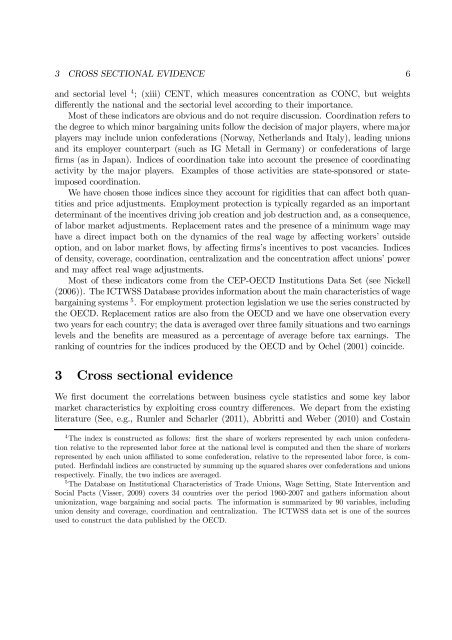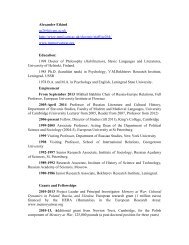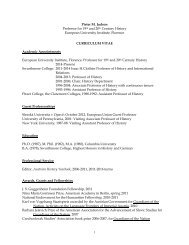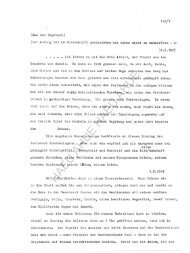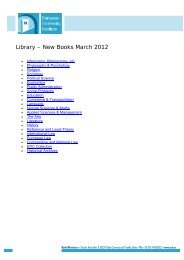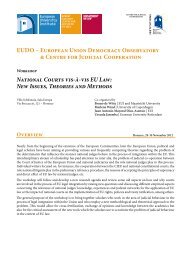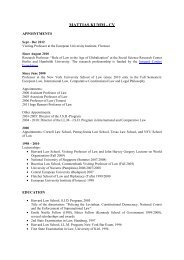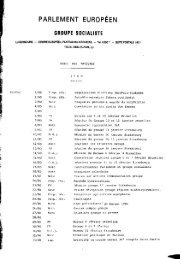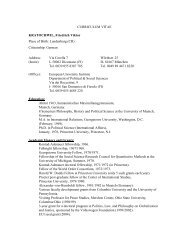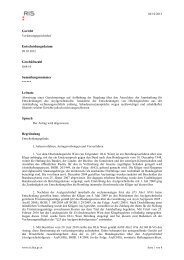Do labor market institutions matter for business cycles?∗ - European ...
Do labor market institutions matter for business cycles?∗ - European ...
Do labor market institutions matter for business cycles?∗ - European ...
You also want an ePaper? Increase the reach of your titles
YUMPU automatically turns print PDFs into web optimized ePapers that Google loves.
3 CROSS SECTIONAL EVIDENCE 6<br />
and sectorial level 4 ; (xiii) CENT, which measures concentration as CONC, but weights<br />
differently the national and the sectorial level according to their importance.<br />
Most of these indicators are obvious and do not require discussion. Coordination refers to<br />
the degree to which minor bargaining units follow the decision of major players, where major<br />
players may include union confederations (Norway, Netherlands and Italy), leading unions<br />
and its employer counterpart (such as IG Metall in Germany) or confederations of large<br />
firms (as in Japan). Indices of coordination take into account the presence of coordinating<br />
activity by the major players. Examples of those activities are state-sponsored or stateimposed<br />
coordination.<br />
We have chosen those indices since they account <strong>for</strong> rigidities that can affect both quantities<br />
and price adjustments. Employment protection is typically regarded as an important<br />
determinant of the incentives driving job creation and job destruction and, as a consequence,<br />
of <strong>labor</strong> <strong>market</strong> adjustments. Replacement rates and the presence of a minimum wage may<br />
have a direct impact both on the dynamics of the real wage by affecting workers’ outside<br />
option, and on <strong>labor</strong> <strong>market</strong> flows, by affecting firms’s incentives to post vacancies. Indices<br />
of density, coverage, coordination, centralization and the concentration affect unions’ power<br />
and may affect real wage adjustments.<br />
Most of these indicators come from the CEP-OECD Institutions Data Set (see Nickell<br />
(2006)). The ICTWSS Database provides in<strong>for</strong>mation about the main characteristics of wage<br />
bargaining systems 5 . For employment protection legislation we use the series constructed by<br />
the OECD. Replacement ratios are also from the OECD and we have one observation every<br />
two years <strong>for</strong> each country; the data is averaged over three family situations and two earnings<br />
levels and the benefits are measured as a percentage of average be<strong>for</strong>e tax earnings. The<br />
ranking of countries <strong>for</strong> the indices produced by the OECD and by Ochel (2001) coincide.<br />
3 Cross sectional evidence<br />
We first document the correlations between <strong>business</strong> cycle statistics and some key <strong>labor</strong><br />
<strong>market</strong> characteristics by exploiting cross country differences. We depart from the existing<br />
literature (See, e.g., Rumler and Scharler (2011), Abbritti and Weber (2010) and Costain<br />
4 The index is constructed as follows: first the share of workers represented by each union confederation<br />
relative to the represented <strong>labor</strong> <strong>for</strong>ce at the national level is computed and then the share of workers<br />
represented by each union affiliated to some confederation, relative to the represented <strong>labor</strong> <strong>for</strong>ce, is computed.<br />
Herfindahl indices are constructed by summing up the squared shares over confederations and unions<br />
respectively. Finally, the two indices are averaged.<br />
5 The Database on Institutional Characteristics of Trade Unions, Wage Setting, State Intervention and<br />
Social Pacts (Visser, 2009) covers 34 countries over the period 1960-2007 and gathers in<strong>for</strong>mation about<br />
unionization, wage bargaining and social pacts. The in<strong>for</strong>mation is summarized by 90 variables, including<br />
union density and coverage, coordination and centralization. The ICTWSS data set is one of the sources<br />
used to construct the data published by the OECD.


